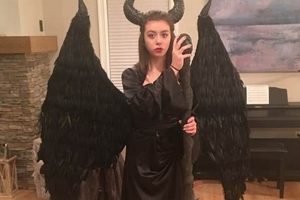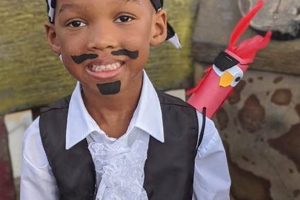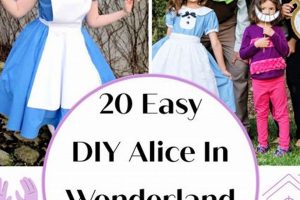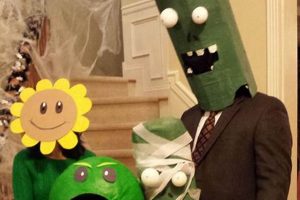The creation of a homemade SpongeBob SquarePants outfit involves constructing or assembling a likeness of the cartoon character using readily available materials and do-it-yourself techniques. An example would be crafting a yellow, square-shaped body from foam, adding facial features cut from felt, and pairing it with brown pants to replicate the animated persona’s distinctive appearance.
Constructing such an attire offers several advantages. It presents a cost-effective alternative to purchasing pre-made costumes, allows for personalization and unique design elements, and fosters creativity and resourcefulness. Historically, crafting costumes at home has been a common practice, allowing individuals to express themselves and participate in events without substantial financial investment. This approach is particularly valuable for fans seeking a specific or customized version not commercially available.
The subsequent article will delve into the specific methods, materials, and considerations involved in successfully realizing a personalized interpretation of the iconic sea sponge’s image.
Essential Considerations for a SpongeBob SquarePants Outfit Construction
Achieving a successful homemade interpretation necessitates careful planning and execution. The following tips provide guidance for a visually accurate and durable representation.
Tip 1: Material Selection: Opt for durable materials like high-density foam or sturdy cardboard for the primary body structure. These materials offer support and maintain the desired square shape. Consider breathable fabrics for inner layers to enhance comfort during wear.
Tip 2: Accurate Proportions: Adhere to the character’s distinctive proportions. A disproportionately large or small head can detract from the overall effect. Refer to official character guides for precise measurements.
Tip 3: Facial Feature Detailing: Prioritize accurate representation of the eyes, mouth, and freckles. Utilize high-quality felt or paint that will not easily fade or peel. Ensure proper adhesion of facial features to the primary structure.
Tip 4: Color Consistency: Maintain color consistency with the character’s established palette. Utilize a bright, consistent yellow for the body, and accurately match the colors of the tie, pants, and other accessories.
Tip 5: Structural Integrity: Reinforce weak points, such as corners or seams, with durable adhesives or stitching. This will prevent structural failure during movement and activity.
Tip 6: Wearability and Comfort: Incorporate design elements that enhance wearability, such as adjustable straps or breathable linings. Consider visibility by ensuring adequate openings for sight and ventilation.
Tip 7: Accessory Accuracy: Pay close attention to the details of accessories, such as the tie and belt. Accurately replicate their size, shape, and color to enhance the overall authenticity.
Adhering to these guidelines increases the likelihood of creating a visually appealing, durable, and comfortable representation. Careful attention to detail is paramount in achieving a recognizable and effective result.
The subsequent section will address common challenges encountered during the construction process and offer solutions for overcoming them.
1. Material Selection
Material selection represents a critical juncture in the effective realization of a SpongeBob SquarePants outfit. The chosen materials directly impact the costume’s appearance, structural integrity, comfort, and overall durability. Improper material selection can compromise the visual accuracy and longevity of the project.
- Body Construction Material
The primary material used for constructing the character’s body significantly affects the costume’s shape and structural stability. Options range from rigid materials like cardboard or foam board to flexible materials such as upholstery foam or fabric. Cardboard, while inexpensive, may lack durability. Foam board offers a balance of rigidity and lightweight properties. Upholstery foam provides greater comfort but can be more challenging to shape. The selection should be based on the desired level of structural support, visual accuracy, and wearer comfort.
- Facial Feature Materials
The materials chosen for creating the eyes, mouth, and other facial features contribute significantly to the costume’s overall likeness. Felt, craft foam, and paint are commonly employed. Felt offers ease of use and affordability but may lack vibrancy. Craft foam provides greater durability and can be easily cut and shaped. Paint allows for precise color matching but requires careful application to avoid smudging or bleeding. The selected materials should be durable, colorfast, and easily adhered to the primary body material.
- Clothing and Accessory Fabrics
The fabrics used for SpongeBob’s clothing, such as his shirt, tie, and pants, contribute to the costume’s authenticity and comfort. Cotton, polyester, and felt are common choices. Cotton offers breathability and comfort but may wrinkle easily. Polyester provides durability and wrinkle resistance but can be less breathable. Felt is often used for accessories like the tie due to its stiffness and ease of cutting. The fabric selection should consider breathability, durability, and ease of cleaning.
- Adhesive and Fastening Materials
Adhesive selection is crucial for securely attaching various components of the outfit. Hot glue, fabric glue, and spray adhesive are commonly used. Hot glue provides a strong bond but can be prone to cracking if applied too thickly. Fabric glue is designed for bonding fabrics and offers a more flexible hold. Spray adhesive provides even coverage but can be messy. The selected adhesive should be compatible with the chosen materials and provide a durable, long-lasting bond. Additionally, fasteners like Velcro or snaps may be needed for closures and adjustable elements.
The appropriate material selection process ultimately determines the quality, durability, and visual appeal of the finished SpongeBob SquarePants outfit. Careful consideration of each material’s properties and suitability for its intended purpose is essential for a successful outcome. This includes balancing cost, availability, and ease of use with the desired level of realism and longevity.
2. Structural Design
The structural design constitutes a foundational element in the successful creation of a homemade SpongeBob SquarePants outfit. It dictates the costume’s overall shape, stability, and ability to withstand wear. Proper structural planning is essential for achieving a recognizable and durable representation of the character.
- Internal Support Framework
The internal support framework is the core elem
ent that maintains the costume’s square shape. This may involve using materials like PVC pipe, wire framing, or strategically placed cardboard or foam reinforcements. The framework must be robust enough to support the costume’s outer layers and maintain its form under movement. For example, a PVC pipe skeleton can provide rigid support, while flexible wire framing allows for some degree of movement and contouring. The implications of a weak or poorly designed framework include deformation of the costume’s shape, instability, and eventual collapse. - Panel Construction and Attachment
The outer panels of the costume typically consist of foam, fabric, or cardboard sections that are attached to the internal framework. The method of attachment is critical for structural integrity. Sewing, gluing, and riveting are common techniques. Sewing provides a strong and flexible bond, while gluing is faster but may be less durable. Riveting offers a secure, mechanical connection. An example of effective panel construction is using interlocking foam panels for a seamless and rigid outer surface. Improper panel attachment can lead to gaps, weak points, and eventual detachment of the outer layers.
- Weight Distribution and Balance
Weight distribution plays a vital role in the wearer’s comfort and mobility. Uneven weight distribution can lead to strain and fatigue. Strategic placement of internal supports and the choice of lightweight materials can mitigate these issues. For example, distributing weight evenly across the shoulders and back can reduce strain compared to concentrating weight in the front. The implications of poor weight distribution include discomfort, limited mobility, and potential injury to the wearer.
- Entry and Exit Mechanisms
The design must incorporate a practical entry and exit mechanism that allows the wearer to easily don and remove the outfit. This may involve zippers, Velcro closures, or strategically placed openings. The placement and design of these mechanisms should not compromise the costume’s overall appearance or structural integrity. For example, a hidden zipper along a seam can provide a discreet and functional entry point. Poorly designed entry and exit mechanisms can make the costume difficult to wear and remove, potentially leading to frustration and damage.
These structural elements are interdependent and must be carefully considered in relation to one another. A well-designed internal framework, securely attached panels, balanced weight distribution, and a functional entry/exit mechanism are essential for creating a SpongeBob SquarePants outfit that is both visually accurate and comfortable to wear. Neglecting these aspects can result in a costume that is flimsy, uncomfortable, and ultimately, unsuccessful in its representation of the character.
3. Color Accuracy
Color accuracy is paramount in achieving a recognizable and aesthetically pleasing homemade SpongeBob SquarePants outfit. Deviations from the character’s established color palette can significantly detract from the costume’s visual fidelity, rendering it less identifiable and impacting its overall impact. This connection is rooted in the character’s iconic design, where specific hues contribute significantly to its immediate recognition. For example, a SpongeBob with a muted yellow or an orange tinge, rather than the vibrant, consistent yellow, immediately diminishes the character’s iconic silhouette. In effect, inaccurate color application directly undermines the visual success of the costume.
The practical application of accurate colors extends beyond mere aesthetics. Consistent color usage reinforces the character’s established brand and ensures uniformity across different interpretations. When crafting a homemade outfit, sourcing materials that closely match the character’s official colors is essential. Fabric dye techniques may be employed to achieve the precise shade of yellow for the body, ensuring that it aligns with established visual representations. Likewise, careful selection of paint colors for facial features and accessory fabrics guarantees a cohesive and recognizable design. The implications of neglecting this accuracy are evident in costumes that appear unpolished or misrepresent the character’s design. A brown rather than red tie, for instance, drastically alters the character’s visual impact.
In conclusion, color accuracy functions as a critical determinant in the overall success of a crafted SpongeBob SquarePants outfit. Challenges in achieving precise color matching can be mitigated through careful material selection, dye techniques, and reference to official color guides. The fidelity of color replication directly affects the costume’s recognizability and its ability to effectively represent the iconic character, making it a non-negotiable aspect of the crafting process.
4. Facial Detailing
Facial detailing is a crucial element in the creation of a SpongeBob SquarePants outfit. The accuracy and execution of these details directly impact the costume’s recognizability and overall success in representing the character. It is not merely an aesthetic addition but a fundamental aspect of the likeness.
- Eye Proportions and Placement
The size, shape, and spacing of the eyes are key identifiers of the character. Overly small or large eyes, or incorrect spacing between them, can significantly alter the character’s appearance. Accurate replication requires precise measurements and careful placement on the costume’s face. Deviations from the standard design can result in a distorted or unrecognizable representation. For example, eyes placed too high on the head can create an unnatural or comical effect that detracts from the overall fidelity.
- Mouth Shape and Expression
SpongeBob’s mouth is characterized by its wide, open shape and distinctive teeth. Accurately replicating this requires careful attention to its dimensions and the curvature of the smile. A mouth that is too narrow or lacking the characteristic teeth will not effectively convey the character’s jovial expression. The material used for the mouth, whether felt, foam, or paint, must also be chosen to ensure a clean and well-defined shape. An inaccurate mouth can fundamentally change the perceived emotion of the costume.
- Freckle Positioning and Quantity
The freckles are a defining feature of SpongeBob’s face, contributing to his unique and whimsical appearance. The number, size, and distribution of these freckles are crucial for accurate representation. Too few or too many freckles, or their placement in an incorrect pattern, can detract from the costume’s overall likeness. Uniformly sized and spaced freckles offer a more authentic impression than randomly scattered dots. Inaccurate freckles can create a sense of imbalance or artificiality in the facial design.
- Eyelashes and Other Minor Features
While less prominent than the eyes, mouth, or freckles, subtle features such as eyelashes contribute to the overall impression. The presence or absence of eyelashes, and their style (e.g., thickness, length, curvature), can subtly alter the character’s expression. These small details demonstrate a commitment to accuracy and elevate the overall quality of the costume. Neglecting these minor elements can result in a less polished and less convincing representation of the
character.
These elements of facial detailing work in concert to create a recognizable and effective representation of SpongeBob SquarePants. Each component, from the placement of the eyes to the subtle addition of eyelashes, contributes to the overall success of the costume. Prioritizing accuracy and attention to detail in these aspects is essential for a successful homemade outfit.
5. Wearer Comfort
The inherent design challenges associated with replicating the square, rigid form of SpongeBob SquarePants necessitates a prioritized focus on wearer comfort. Constructing such a costume inherently deviates from natural human anatomy, potentially restricting movement, limiting ventilation, and causing discomfort during extended wear. Failure to adequately address these factors can result in a costume that is visually accurate but practically unusable, negating the investment of time and resources.
Several design considerations directly impact the wearer’s experience. Material selection plays a crucial role; rigid materials like cardboard, while maintaining the desired shape, offer minimal breathability and can chafe against the skin. Conversely, flexible foam provides greater comfort but may compromise structural integrity. Incorporating ventilation systems, such as strategically placed mesh panels or internal fans, mitigates heat buildup. Adjustable straps and internal padding can improve fit and reduce pressure points, distributing weight more evenly across the shoulders and torso. Real-world examples illustrate this point; costumes lacking proper ventilation quickly become unbearable, while those with poorly designed internal supports can cause back pain or restricted movement.
In conclusion, the successful creation of a SpongeBob SquarePants outfit requires a careful balance between visual accuracy and wearer comfort. Prioritizing ergonomic design, selecting breathable materials, and incorporating ventilation systems are crucial considerations. The practical significance of this understanding lies in producing a costume that is not only visually appealing but also wearable and enjoyable, ensuring its usability for intended events or performances. Neglecting wearer comfort renders the costume ineffective, regardless of its aesthetic qualities.
6. Durability
Durability represents a key factor in the successful and extended utilization of a homemade SpongeBob SquarePants outfit. The inherent investment of time, materials, and effort in constructing such a costume necessitates consideration of its ability to withstand repeated use and environmental factors.
- Material Resilience
The selection of durable materials directly affects the costume’s ability to resist wear and tear. Fabrics prone to tearing, adhesives that weaken over time, and paints that fade or chip compromise the outfit’s structural integrity and visual appeal. Employing robust fabrics like canvas or reinforced felt, utilizing high-strength adhesives, and applying UV-resistant paints significantly enhance the costume’s lifespan. For example, a costume constructed with thin cardboard panels and water-based paints is likely to deteriorate rapidly compared to one made from durable foam and acrylic paints.
- Construction Integrity
The methods employed in assembling the costume components influence its overall robustness. Weak seams, poorly secured attachments, and inadequate reinforcement can lead to structural failure. Utilizing techniques such as reinforced stitching, robust adhesive bonding, and the strategic placement of internal supports enhance the costume’s ability to withstand stress and movement. An example is reinforcing corners with additional fabric or cardboard to prevent tearing or bending.
- Resistance to Environmental Factors
Exposure to environmental elements, such as moisture, sunlight, and temperature fluctuations, can accelerate the deterioration of costume materials. Fabrics prone to fading in sunlight, adhesives that weaken in humid conditions, and materials that warp with temperature changes compromise the costume’s long-term viability. Selecting weather-resistant materials and employing protective coatings can mitigate these effects. Storing the costume in a dry, dark, and temperature-controlled environment further enhances its longevity. A costume left exposed to direct sunlight is likely to exhibit accelerated fading and material degradation.
- Repairability and Maintenance
The ease with which the costume can be repaired and maintained contributes to its long-term usability. Designs that allow for easy access to damaged areas and the use of readily available replacement materials facilitate repair efforts. Regular cleaning and maintenance, such as spot cleaning stains and re-gluing loose components, extend the costume’s lifespan. A costume with complex, inaccessible construction may be difficult or impossible to repair, ultimately shortening its useful life.
The factors above collectively determine the longevity and overall value of a SpongeBob SquarePants outfit. Prioritizing material resilience, construction integrity, environmental resistance, and repairability ensures a costume that can be enjoyed for multiple events and withstand the rigors of repeated use. The effective balancing of these durability considerations represents a critical element of fabrication.
Frequently Asked Questions
This section addresses common inquiries regarding the creation of a SpongeBob SquarePants outfit. The information provided is intended to guide individuals through the construction process.
Question 1: What is the most suitable material for constructing the body of the outfit?
High-density foam or reinforced cardboard are generally recommended. High-density foam offers a balance of structural integrity and relative comfort. Reinforced cardboard, while more cost-effective, may require additional support to maintain its shape and resist bending.
Question 2: How can accurate color matching be achieved?
Refer to official character guides for precise color codes. Fabric dye techniques can be employed to match fabric colors, while acrylic paints offer versatility for smaller details. Color swatches and comparisons under consistent lighting conditions are recommended to verify accuracy.
Question 3: What methods can be used to enhance wearer comfort within a rigid, square structure?
Ventilation systems, such as strategically placed mesh panels or small, battery-operated fans, are essential. Internal padding, particularly in areas of high pressure, improves comfort. Adjustable straps ensure a secure and customizable fit.
Question 4: How can the outfit’s structural integrity be maintained during extended use?
Reinforce stress points, such as corners and seams, with durable adhesives or stitching. Internal support frameworks, constructed from PVC pipe or wire, provide additional stability. Employing high-quality materials minimizes the risk of tearing or deformation.
Question 5: What are the key considerations for replicating the character’s facial features?
Accurate proportions, precise placement, and consistent color usage are paramount. Stencils or templates can aid in achieving consistent shapes and size
s. Durable materials, such as felt or craft foam, are recommended for longevity.
Question 6: How should the completed outfit be stored to prevent damage?
Store the costume in a dry, dark, and temperature-controlled environment. Avoid direct sunlight or extreme temperatures, which can cause fading or warping. Use a garment bag to protect the outfit from dust and physical damage.
Effective construction and maintenance are crucial to maximizing the longevity and visual appeal of the outfit.
The following section will provide supplementary resources and practical tips.
Concluding Remarks on SpongeBob Costume DIY
The preceding analysis has explored various facets of creating a SpongeBob SquarePants outfit using do-it-yourself methods. Emphasis was placed on material selection, structural design, color accuracy, facial detailing, wearer comfort, and durability as critical determinants of a successful outcome. Understanding the interdependencies of these elements is essential for producing a recognizable and functional representation of the character.
Effective construction of a visually accurate and long-lasting SpongeBob SquarePants outfit represents a synthesis of creative skill, meticulous planning, and informed execution. Attention to detail and a commitment to quality contribute directly to the costume’s overall impact and enduring appeal. Future advancements in material science and fabrication techniques may further refine the process of creating such personalized representations. The enduring popularity of the character ensures continued interest in innovative construction methods.







